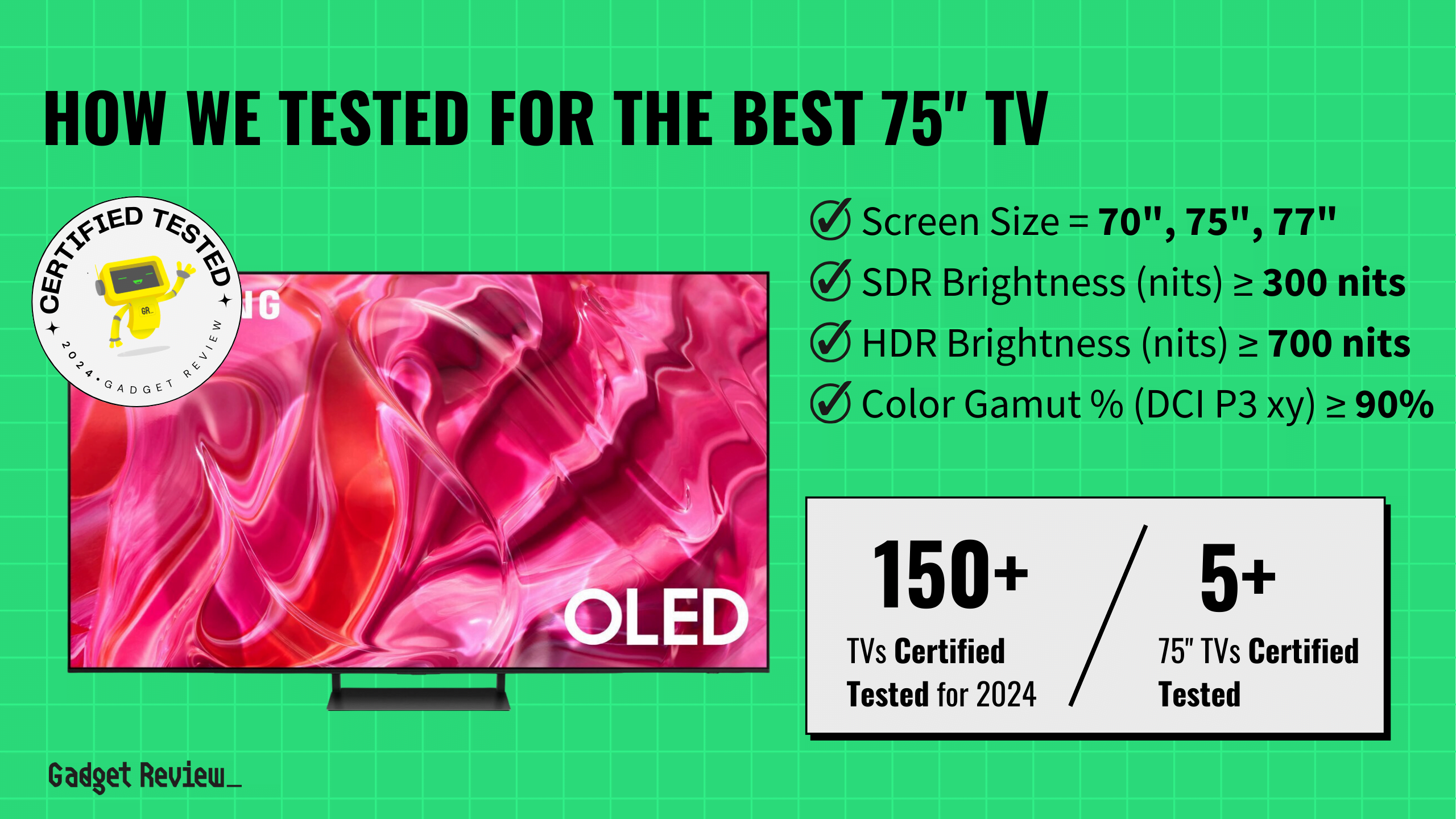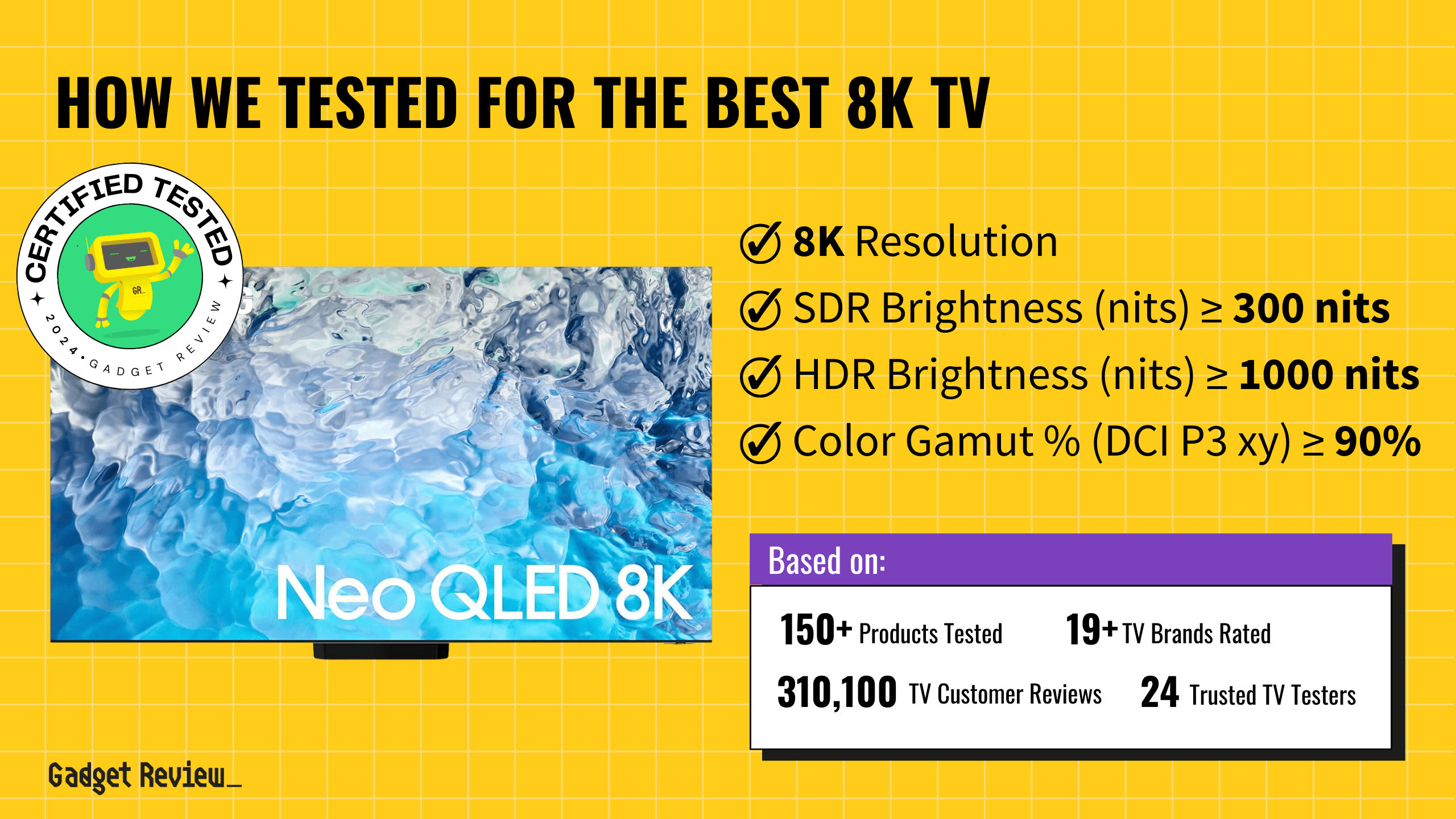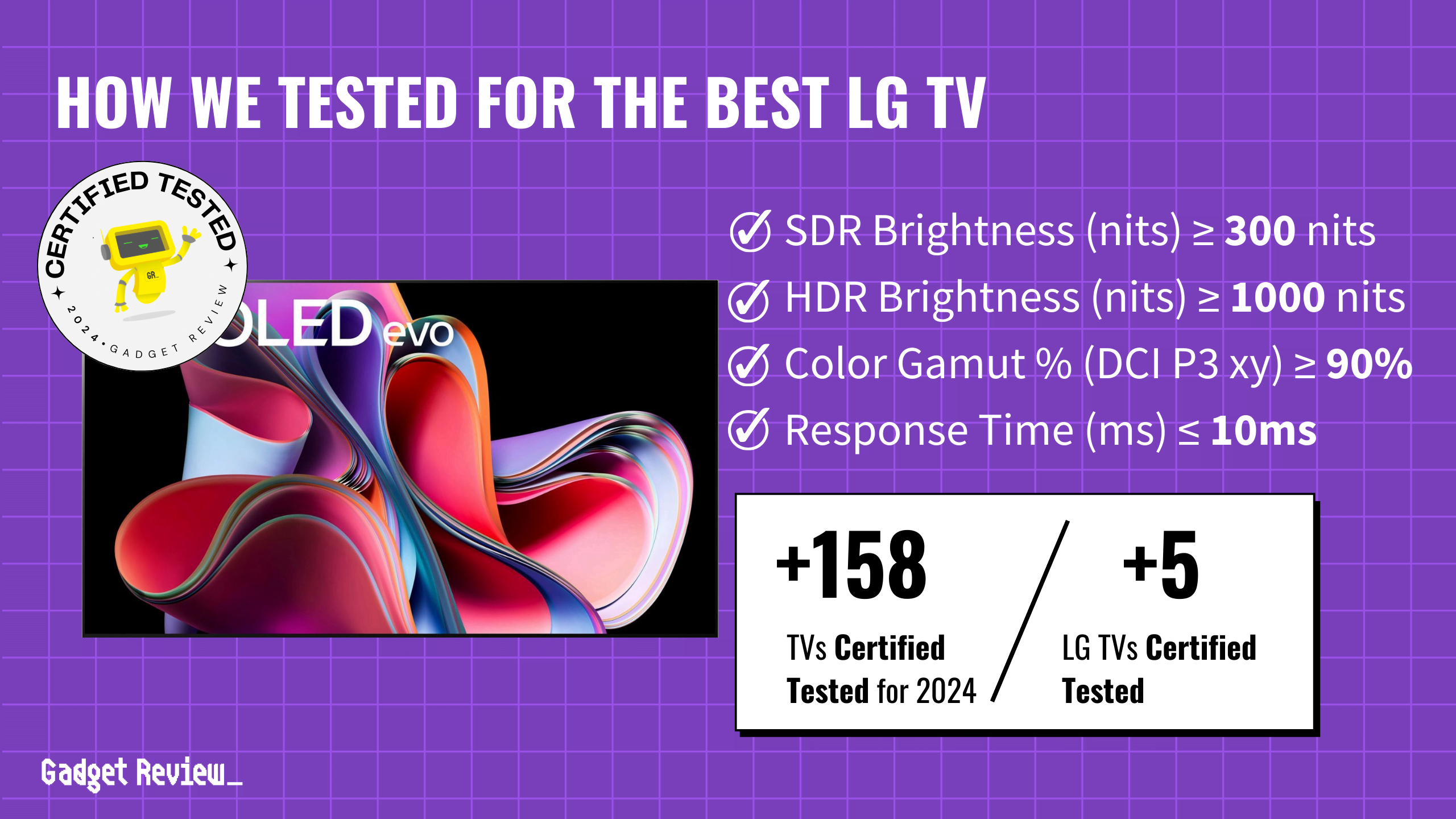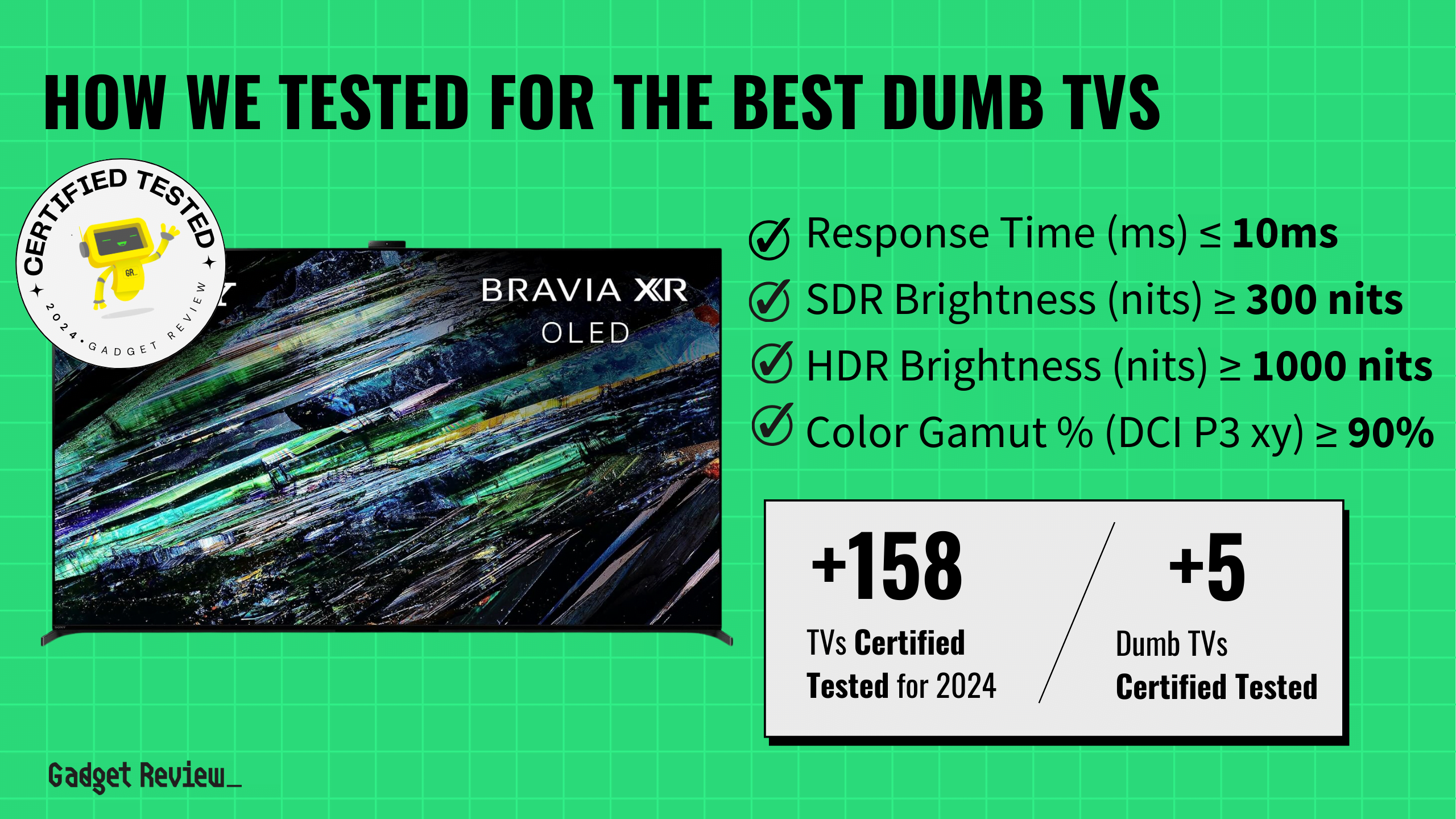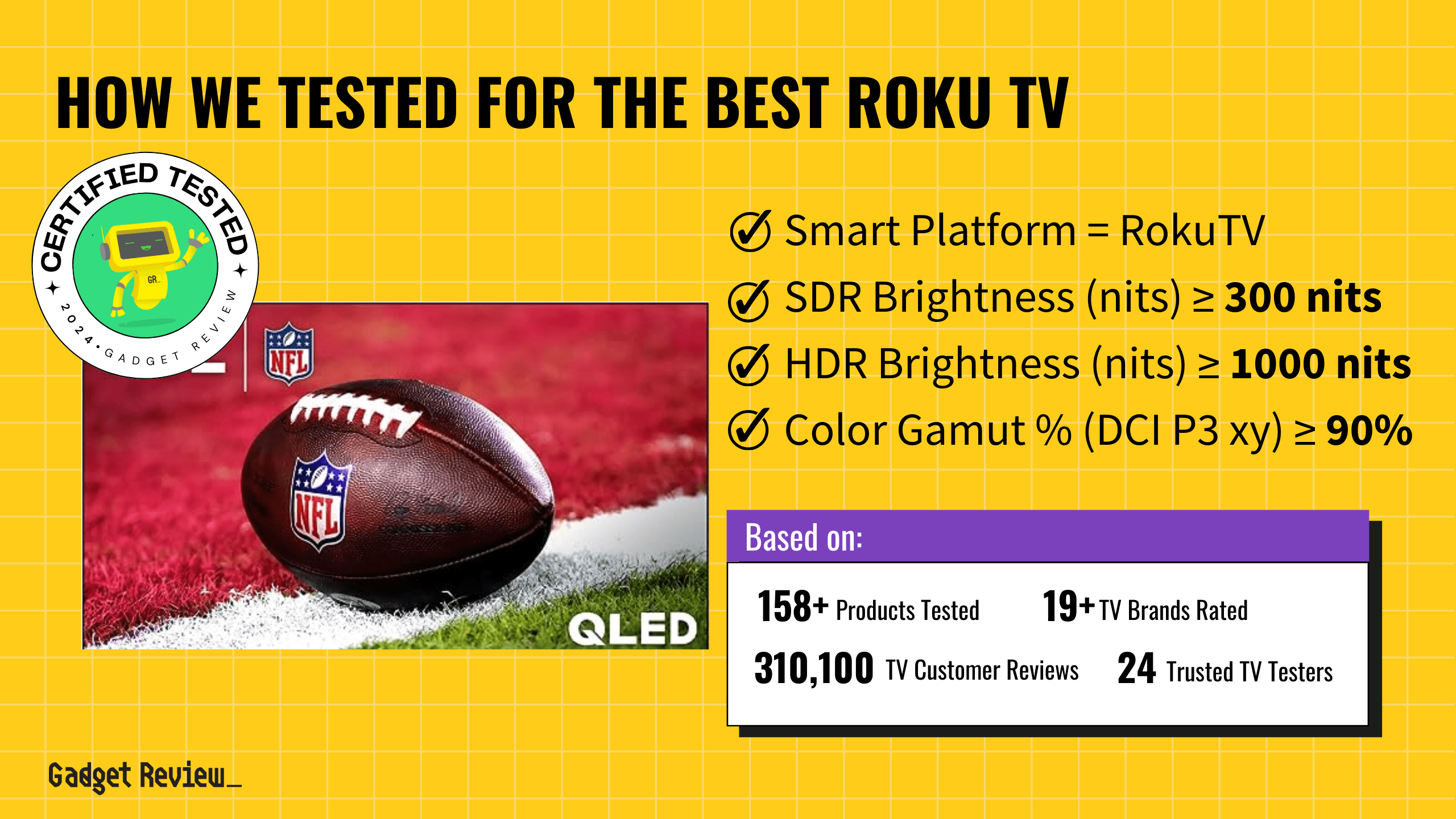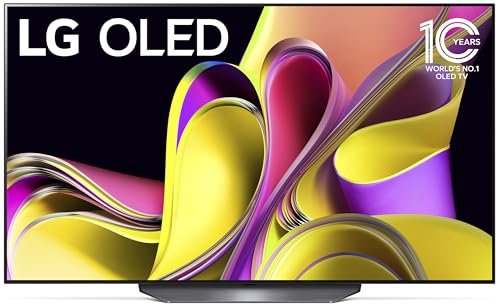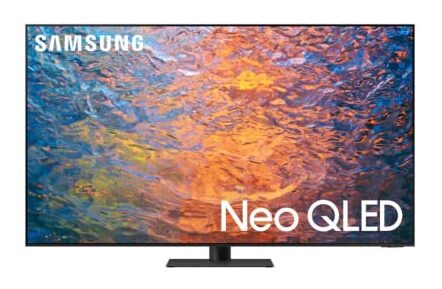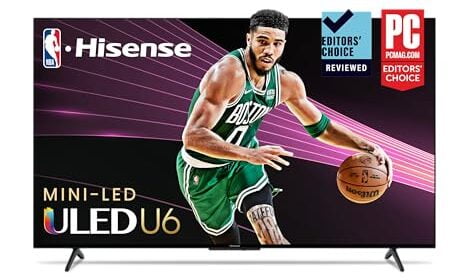The best 75-inch TVs will elevate your viewing experience, blending size with technical prowess, ensuring every detail of the action is delivered with precision. These TVs, ranging from 70 to 77 inches, are designed for those who refuse to compromise on quality, offering a seamless blend of high-definition visuals and performance. With an SDR brightness of 300 and HDR brightness of 700, they illuminate the room with vivid colors and sharp contrasts, ensuring that every scene is as lifelike as possible. The requirement of a 90% DCI P3 color gamut further enhances further, bringing a wide spectrum of colors to life, making every moment on screen more immersive and real. When searching for the best TV, considering these features ensures you’re getting the most out of your investment.
The best 75-inch TVs covers all budget ranges, from budget-friendly to premium, all backed by solid test data to ensure you make the perfect choice for sports, movies, or any viewing preference. Whether you’re on a tight budget or looking for top-tier features, you’ll find a model that meets your needs without sacrificing quality.
How Did We Rank the Best 75 Inch TVs?
To assess how high or low quality a 75-inch TV actually is, one must evaluate specific testing criteria against reference industry standards. Using our thorough TV Testing Methodology, we determined there are 1 minimum specs and 6 criteria below (3 required, 3 nice to have) that ensure your 75-inch TV content looks as good as the creator intended it.
- Minimum Specifications
- Screen Size: 70″, 75″, 77″, offering expansive viewing for immersive entertainment.
- Test Criteria
- SDR Brightness: Achieving a minimum of 300 nits ensures a bright, clear picture in any lighting condition.
- HDR Brightness: 700 nits or more brings out intricate details in high dynamic range content.
- Color Gamut: Covering at least 90% of the DCI P3 color gamut delivers vibrant and true-to-life colors.
- “Nice To Haves”
- Contrast Ratio: Preferably 10,000:1 or higher, providing rich depth with deep blacks and bright whites.
- EOTF Accuracy: Delta E less than or equal to 0.018 ensures precise brightness and contrast.
- Fast Response Time: 10ms or less, ensuring smooth transitions without motion blur.
We’ve redefined TV buying guides, setting us apart from any other site on the planet. Our unique approach combines in-house verification with a comprehensive dataset from over 200+ trusted sites, focusing on key testing metrics to rank the top rated 75 inch TVs. Testing data and specs include brightness (SDR and HDR), color accuracy, and a set that is 70″, 75″, or 77″. We aggregate and analyze this data from 158+ TVs, ensuring our recommendations meet your specific needs. In this case, it’s for 75 inch TVs, which means delivering exceptional brightness and color accuracy for an immersive viewing experience. Discover our data-driven methodology for precise, reliable TV recommendations.
Latest Updates
- 03/11/2024: Completely and thoroughly overhauled the guide to include the best and latest 75 Inch TVs.
- 11/30/2023: Republished the list to include TVs based on our True Score system.
Top 75 Inch TVs For 2025
Prices accurate at the time of publishing
For our list, a 75-inch TV must dazzle with 300+ nits brightness for SDR and 700+ nits for HDR. Color accuracy should hit 90% of the DCI P3 color gamut. If not, it’s out!

Best Overall

Runner Up

Best Value

Best Budget

Best Mid-Range

Premium Pick
Samsung S90C TV
Best For Sports
Samsung’s S90C delivers unmatched OLED contrast and color accuracy for home theater enthusiasts, with excellent glare reduction and ultra-responsive gameplay, ideal for moderately lit rooms.
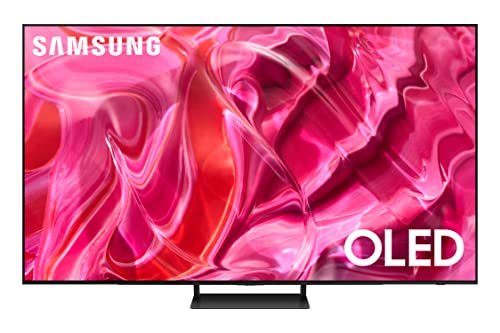
True Score
91938Experts
935kCustomers
Cosmic Wonder
 $1,997.95
$1,997.95Read More
Snapshot
Reasons to Buy
- Excellent picture quality
- The near-infinite contrast ratio for perfect blacks
- High peak brightness
- Exceptionally wide viewing angle
- Low input lag/Response time
- Sharp upscaling
Reasons to Avoid
- Aggressive Auto Brightness Limiter (ABL)
- No support for DTS or Dolby Vision
Specifications

Backlight Type n/a Display Type OLED HDMI Inputs 4 
HDMI Type HDMI 2.1 HDR Format HDR10+, HLG 
HomeKit Compatible No Max Resolution 3840 x 2160 (4k) 
Number of Audio Channels 2.1 
Panel Type OLED Refresh Rate 120 Hz, 144 Hz Screen size 55″, 65″, 75″, 83″ 
Smart Platform Tizen 
Speaker Output 40 Watts 
Sync Technology AMD FreeSync Premium 
VRR Yes All Specs
Test Results
Color Gamut % (DCI P3 xy) 99.975 Color Gamut % (DCI P3 uv) 99.95 Color Gamut % (Rec 2020 xy) 86.37 Color Gamut % (Rec 2020 uv) 91.59 Color Gamut % (sRGB) 0 Color Gamut % (Rec 709) 0 Color Gamut % (BT.2020) 76 Color Gamut % (Adobe RGB) 0 Color Gamut % (BT.709) 0 Contrast Ratio (x:1) 0 SDR Brightness (nits) 373 HDR Brightness (nits) 1,058 Input Lag (ms) 8.5 Response Time (ms) 1.4 Color Washout (Degrees) 70 Color Shift (Degrees) 70 Brightness Loss (Degrees) 70 Reflections (%) 1.2 Low-Freq Extension (Hz) 84.76 Freq Response StdDev @ 70db 2.8 Freq Response StdDev @ 80db 3.63 Weighted Total Harmonic Distortion @80db 0.133 Intermodulation Distortion @80db 2.47 EOTF (600 nit delta) 0.0031 EOTF (1000 nit delta) 0.0036 EOTF (4000 nit delta) 0.0024 All Tests
All Retailers
- $1,997.95
Availability
In StockFree Shipping
No - $2,049.00
Availability
In StockFree Shipping
No - $2,299.99$2,500Save $200
Availability
In StockFree Shipping
No - $2,697.99$3,598Save $900
Availability
In StockFree Shipping
Our Verdict
Samsung’s S90C is one of the best 75-inch TVs thanks to its performance and OLED technology. While its SDR brightness and HDR brightness aren’t the highest, coming in at 373 nits and 1058 nits respectively, the TV is still bright enough for moderately lit spaces, especially when watching HDR content. The S90C boasts the highest color gamut coverage, however, at 99.98%, which means it pairs well with what OLED panels are known most for: perfect blacks and infinite contrast. This makes the S90C’s viewing experience notably rich and detailed, especially if you’re a home theater fanatic.
The S90C also features excellent reflection handling, reflecting just 1.2% of light, so whatever light does get into the room won’t cause unbearable glare. This is great for sports fans, because the low glare, wide viewing angle and best-in-class response time of 1.4 ms means that Superbowl parties will be free of any kind of motion-blur during fast-paced plays, no matter where you’re seated. Thanks to the onboard Tizen OS, you’ll also have plenty of streaming options for not just sports, but also movies and TV shows.
If you’re a gamer, the S90C also has best-in-class input lag, coming in at just 8.5 ms. Between this low input lag and the extremely fast response time, the S90C is a phenomenal choice for gamers looking for exceptional visual quality and ultra responsive gameplay, while minimizing motion blur and loss of detail when things get fast.
Overall, the S90C earns its place as one of the best 75-inch TVs you can buy. It may be the most expensive option, but its performance in every type of content you can throw at it makes it hard to pass up. With deep blacks and vibrant colors, the only place the S90C struggles outside of budget is very bright rooms, but that’s to be expected with current generation OLEDs.
Read Less

Best Overall

Runner Up

Best Value

Best Budget

Best Mid-Range

Premium Pick
Hisense U7K
The Hisense U7K combines solid brightness and HDR quality with great value, making it an excellent all-rounder for sports fans and casual gamers in dim to moderately lit rooms.
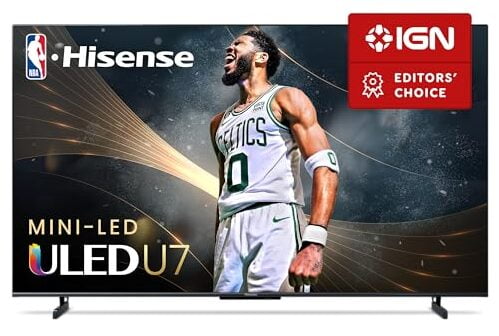
True Score
83859Experts
87522Customers
Absolutely Fresh
 SAVE $165$1,099.99$934.99
SAVE $165$1,099.99$934.99Read More
Snapshot
Reasons to Buy
- Outstanding picture quality in the dark
- High peak brightness
- Fast response time and low input lag
- 120 Hz refresh rate
Reasons to Avoid
- Subpar off-center viewing
- Average blooming
Specifications

Backlight Type Full-Array Display Type LED HDMI Inputs 4 
HDMI Type 2.0, HDMI 2.1 HDR Format Dolby Vision, HDR10, HDR10+, HLG 
HomeKit Compatible – Max Resolution 3840 x 2160 (4k) 
Number of Audio Channels 2.1 
Panel Type IPS Refresh Rate 120 Hz Screen size 55″, 65″, 75″ 
Smart Platform Google TV 
Speaker Output 40 Watts 
Sync Technology HDR Format 
VRR Yes All Specs
Test Results
Color Gamut % (DCI P3 xy) 96.31 Color Gamut % (DCI P3 uv) 97.4 Color Gamut % (Rec 2020 xy) 76.18 Color Gamut % (Rec 2020 uv) 81.91 Color Gamut % (sRGB) 98.5 Color Gamut % (Rec 709) 0 Color Gamut % (BT.2020) 76 Color Gamut % (Adobe RGB) 80.5 Color Gamut % (BT.709) 0 Contrast Ratio (x:1) 45,000 SDR Brightness (nits) 603 HDR Brightness (nits) 786.5 Input Lag (ms) 14.3 Response Time (ms) 11.3 Color Washout (Degrees) 23 Color Shift (Degrees) 23 Brightness Loss (Degrees) 35 Reflections (%) 1.9 Low-Freq Extension (Hz) 89.8 Freq Response StdDev @ 70db 4.36 Freq Response StdDev @ 80db 4.48 Weighted Total Harmonic Distortion @80db 0.096 Intermodulation Distortion @80db 4.47 EOTF (600 nit delta) 0.0211 EOTF (1000 nit delta) 0.021 EOTF (4000 nit delta) 0.013 All Tests
All Retailers
- $934.99$1,100Save $165
Availability
In StockFree Shipping
No - $1,186.38
Availability
In StockFree Shipping
No - $1,400.00
Availability
In StockFree Shipping
No
Our Verdict
The Hisense U7K is one of the Best Value TVs in the 75-inch category thanks to its excellent blend of price and performance that make it well suited to a wide audience. While not reaching the peak brightness of its sibling, the U8K, the U7K’s brightness is still robust, providing a pleasant viewing experience without the intensity that might be overwhelming in certain environments. With an SDR brightness of 603 nits and an HDR bright of 786 nits, the TV performs well in dim and moderately lit rooms, making it great for home theaters or game rooms, especially since it can also use Dolby Vision to further enhance HDR content.
A reflection rate of 1.9% and a response time of 11.3 ms means the U7K is positioned as a solid choice for general viewing and sports in rooms with mild amounts of light without having excessive glare obscuring the picture. It even beats its brother, the U8K, in response time, making it well-suited for sports fans on a budget.
If you’re a hardcore gamer, however, input lag of the U7K is where it falls short. At 14.3 ms, the U7K is best suited for playing more casual games if you’re a diehard competitor that needs the tiniest delay possible between your inputs and on-screen action. However, if casual gaming is your speed, then the excellent price of the U7K and sufficient input lag pair well together, especially given that it comes in a 75-inch package.
As far as well-rounded packages go, the U7K is a fantastic value for a 75-inch TV that balances brightness and HDR performance with capable performance that comes close to the better ranked – and more expensive – options on our list. Its capabilities make it a suitable option for viewers looking for a versatile television that can adapt to different types of content and viewing environments, ensuring a quality experience across a spectrum of use cases without breaking the bank.
Read Less
Category Snapshot
TVs
- Total Brands/Products Tested
17 Brands, 158 Products
- Top 2 Brands
LG, Hisense
- Price Range (Budget-Premium)
$400-$2000
- Average True Score
76.65
- Important Test Criteria
Brightness (cd/m2)
Contrast Ratio (1000:1) - Most Trusted Testers

- Top TV Experts
- Recommended Retailer

- Typical Warranty
1 year
- Covered by Insurance
Yes – AKKO
- Test Methodology

Best Overall

Runner Up

Best Value

Best Budget

Best Mid-Range

Premium Pick
Hisense U8K TV
Best For Home Theater
Offering unparalleled brightness, the Hisense U8K excels in brightly lit environments, providing vibrant colors and detailed HDR content, making it a versatile choice for cinephiles and casual gamers alike.
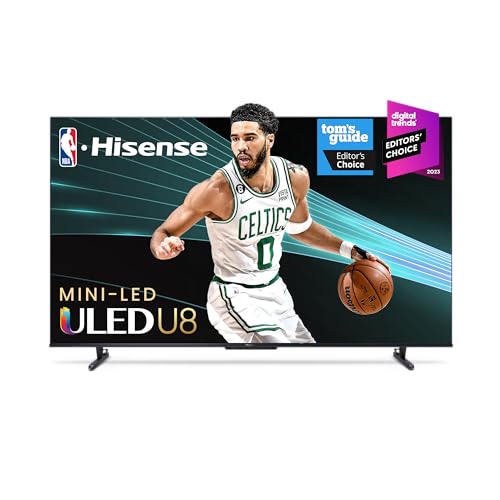
True Score
80806Experts
851kCustomers
Absolutely Fresh
 SAVE $260$1,299.99$1,039.99
SAVE $260$1,299.99$1,039.99Read More
Snapshot
Reasons to Buy
- Good picture quality
- Outstanding brightness and good contrast ratio
- Quick response time
- Great reflection handling
Reasons to Avoid
- Poor viewing angles
Specifications

Backlight Type Full-Array Display Type LED 
HDMI Type HDMI 2.1 
Depth 3″ HDMI Inputs (Total) 4 HDR Format Dolby Vision, HDR10, HDR10+, HLG 
Height 33.1″ High Dynamic Range (HDR) Yes Max Resolution 3840 x 2160 (4k) 
Number of Audio Channels 2.1.2 
Panel Type VA Refresh Rate 144 Hz Screen size 100″, 55″, 65″, 75″, 85″ 
Smart Platform Google TV 
Speaker Output 50 Watts 
Voice Assistant Google Assistant 
Weight 56.4″ lbs 
Width 57.2″ 
Works With Google Assistant All Specs
Test Results
Color Gamut % (DCI P3 xy) 97.44 Color Gamut % (DCI P3 uv) 97.01 Color Gamut % (Rec 2020 xy) 76.18 Color Gamut % (Rec 2020 uv) 81.82 Color Gamut % (sRGB) 0 Color Gamut % (Rec 709) 0 Color Gamut % (BT.2020) 80 Color Gamut % (Adobe RGB) 0 Color Gamut % (BT.709) 0 Contrast Ratio (x:1) 165,360 SDR Brightness (nits) 1,549 HDR Brightness (nits) 1,792 Input Lag (ms) 14.2 Response Time (ms) 13.3 Color Washout (Degrees) 23 Color Shift (Degrees) 23 Brightness Loss (Degrees) 35 Reflections (%) 1.8 Low-Freq Extension (Hz) 80 Freq Response StdDev @ 70db 2.06 Freq Response StdDev @ 80db 2.11 Weighted Total Harmonic Distortion @80db 0.1 Intermodulation Distortion @80db 0.71 EOTF (600 nit delta) 0.0105 EOTF (1000 nit delta) 0.0106 EOTF (4000 nit delta) 0.011 All Tests
All Retailers
- $1,039.99$1,300Save $260
Availability
In StockFree Shipping
No - $1,700.00$1,798Save $98
Availability
In StockFree Shipping
No - $1,808.43
Availability
In StockFree Shipping
No
Our Verdict
If you’re looking for standout brightness to overcome tons of ambient light, the Hisense U8K may be what you need. Its best-in-class SDR and HDR brightness of 1549 nits and 1792 nits respectively cements its runner-up status by positioning the TV as uniquely suited to conquering bright rooms.
The bright panel keeps color vivid and safe from sunlight, and thanks to the 97.44% color gamut coverage, the set manages excellent color accuracy alongside decent gamma accuracy with its EOTF of 0.0105. These two measurements, coupled with the high brightness and support for Dolby Vision make the U8K an excellent choice for home theaters that are brightly lit as often as they’re dark.
The set’s reflection handling, coming in at 1.8% light reflected, is also excellent and helps minimize glare on the screen to prevent details from being lost. Unfortunately, its response time of 13.3 ms means the TV struggles more than others on the list during high intensity sports content. It’s still quite good, coming in well under our minimums, but the S90C beats it easily… if you’re willing to pay almost double.
Value for performance is fantastic with the U8K, losing only to its brother, the U7K. It’s not the best option for highly competitive gamers given its input lag of 14.3 ms, but it’s still plenty usable for more casual play and for the gamer on a budget, especially if the game room is also very bright.
Brightness is the name of the game with the U8K. If your home theater is often full of natural light, the U8K offers excellent, affordable home theater performance. It’s the most accessible option for cinephiles, and the versatility of the TV is good enough that it can still hold its own with sports and casual games, especially in brightly lit rooms.
Read Less

Our Approach to Testing 75 Inch TVs
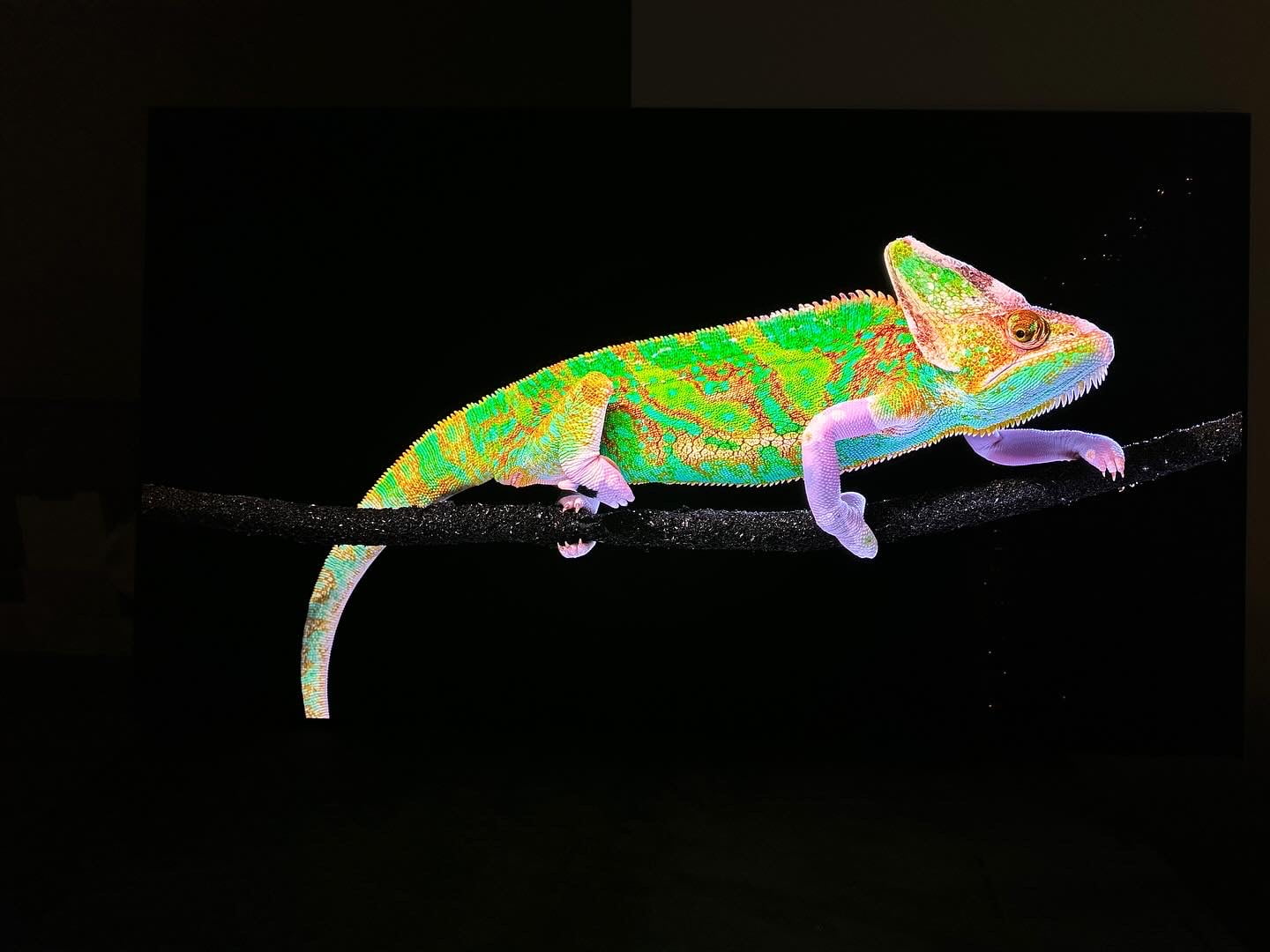
Evan Shepard/Gadget Review
We’ve redefined TV buying guides, setting us apart from any other site on the planet. Our unique approach combines in-house verification with a comprehensive dataset from trusted sites, focusing on key testing metrics like brightness (SDR and HDR), EOTF, response time, contrast ratio and color gamut.
We aggregate and analyze this data, ensuring our recommendations meet the specific needs. Specifically, when it comes to 75 inch TVs, this involves selecting models that deliver optimal image quality for content for 75 Inch TVs. Discover our data-driven methodology for precise, reliable TV recommendations.
You may notice some of our graphs contain “Source: RTings”. This is to indicate that the data we’re showing off in a graph has come from a single source – because it’s the only source that actually tested the criteria and had data for it! Normally, our data is an average out of all of the various publications that test and provide data to give you a good idea of how a product is going to perform on average.
Which Criteria Matters for Testing 75 Inch TVs?
By focusing on these criteria (3 required, 3 nice to have), anyone can quickly and easily compare these TVs and how they’ll perform. This helps you make an informed decision and purchase a TV that will fit into your small or tight space.
| CRITERIA | RANGE | REQUIRED | DEFINITION |
|---|---|---|---|
| SDR Brightness | 300+ nits | Yes | Assess the luminance of your display when operating in Standard Dynamic Range (SDR) mode. |
| HDR Brightness | 700+ nits | Yes | Determine the luminance of your display in High Dynamic Range (HDR) mode. |
| Color Gamut (DCI P3 xy) | >= 90% | Yes | Evaluate the extent to which a TV can reproduce a specified spectrum of colors. |
| EOTF | 0.018 | No (nice to have) | Standard that governs how a display interprets and renders brightness and color. |
| Response Time | <=10ms | No (nice to have) | Time required for a pixel to transition from one color to another and then return to its original color. |
| Contrast Ratio | >= 10,000 | No (nice to have) | The ratio between the brightest white and darkest black that the screen can display. |
Our Trusted Data Sources
(Publication category Score is 80%+)
We looked at 210+ TV reviewers and while 24 are trustworthy (60%+ Trust Rating), we only use data from the testers that are “very trusted” which means a Trust Rating above 70%. The three we have listed below are our most trusted for TVs, along with our own in-house TV expert.
- Evan Shepard – Gadget Review
- Matthew Lopes – RTings, MuckRack
- Will Greenwald – PCMag, MuckRack, Twitter
- David Katzmaier – CNET, MuckRack, Twitter
Interested in a comprehensive analysis of our data sources? We’ve got you covered. Below, you’ll find a detailed list of every TV review website we’ve identified, organized by their respective Trust Ratings from highest to lowest. But we didn’t stop there. We’ve meticulously reviewed each publication and verified the data by checking whether the authors have bio links to MuckRack or LinkedIn. We’re committed to not only checking the facts but ensuring their veracity.
75 Inch TVs Test Data & Results
1. SDR & HDR Brightness TV Test Results
In well-lit rooms, the brightness level of your 75-inch TV, quantified in nits, is key to a great viewing experience. A TV that doesn’t meet the brightness requirement will struggle against natural and artificial light, resulting in a dim, lackluster image. Essentially, nits measure how well your TV can stand up to light interference, with higher values ensuring a sharper, more vivid display.
For standard viewing on the best 75-inch TV, you should look for at least 300 nits to strike the right balance between clarity and color quality in standard dynamic range (SDR) content. For high dynamic range (HDR) content, which offers richer colors and greater contrast, a minimum of 700 nits is ideal to truly appreciate the enhanced visuals. These brightness levels are recommended to ensure your TV performs well in bright settings, allowing you to enjoy your shows and movies without any loss in detail or quality. Aim for these minimums: SDR Brightness >= 300 nits; HDR Brightness >= 700 nits for the optimal experience.
Discover the top 75-inch TVs, ranked from brightest to least, all exceeding our brightness criteria.
Brightness
SDR: 300+ nits
HDR: 700+ nits
Acceptable range of performance
Definition: Maximum brightness in a specified pattern size window. Most commonly measured in a 10% or 100% white window.
Units of Measurement: nits (alternatively cd/m²)
Tools to Measure: TV, luminance meter
Why It’s Important:
Brightness helps counter ambient light so that details and colors don’t wash out and get lost.
SDR Brightness (in nits, higher is better)
HDR Brightness (in nits, higher is better)
2. Color Gamut (DCI P3 xy) TV Test Results
Color Gamut
>= 90%
Acceptable range of performance
Definition: The TV’s capability to display a spectrum of colors.
Units of Measurement: % (color space coverage in percent)
Tools to Measure: Colorimeter
Why It’s Important:
Inaccurate colors compromise the authenticity of the content.
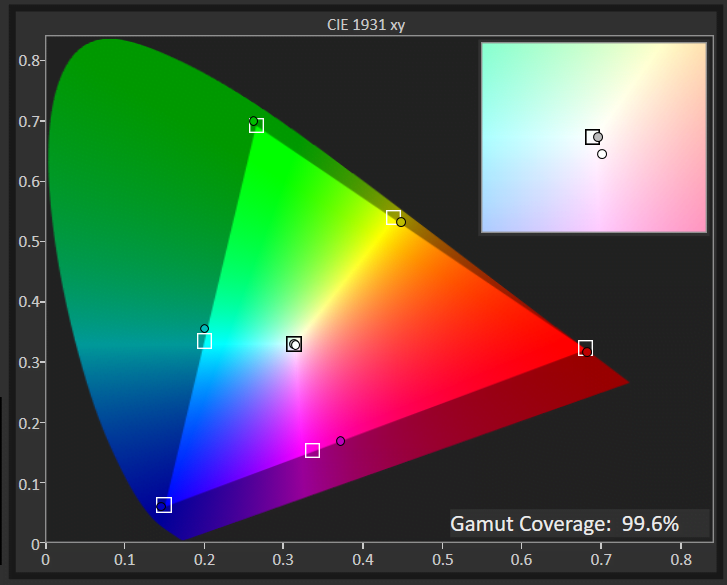
Color gamut defines the range of colors a TV can reproduce, directly affecting how vibrant and true-to-life the images look. A wide color gamut in a 75-inch TV brings out richer, more vivid colors – from the lush greens of a garden to the bright colors of animated characters, enhancing your viewing experience to closely mimic real life.
This concept is technically measured against standards like the DCI P3 xy, a benchmark for high-quality visuals. A 75-inch TV covering a higher percentage of this color space can display colors more accurately and vividly.
For those who prioritize vibrant and immersive visuals in a larger package, aiming for a 75-inch TV with a color gamut of 90% or higher on the DCI P3 xy scale is ideal. This ensures that the content you watch is as vibrant and lifelike as possible, bringing that big viewing experience you desire.
Below are the top 75-inch TVs, ordered by color gamut, all exceeding our testing criteria.
DCI P3 XY Color Gamut (as a %; high is better)
3. EOTF Test Results
The Electro-Optical Transfer Function (EOTF) plays a critical role in ensuring the content on your TV looks exactly as the creator intended. This technical feature adjusts your screen’s brightness levels, ensuring every scene, from the darkest shadows to the brightest highlights, is displayed with true-to-life accuracy.
In rooms flooded with light, a TV that nails EOTF calibration shines by preserving the intended contrast and detail in the picture despite the challenging conditions. It balances the brightness so that images remain vibrant and full of detail, unaffected by the glare of ambient light.
A TV that excels in managing EOTF offers an immersive and authentic viewing experience. It brings creators’ visions to life, accurately rendering every scene with the proper light and dark levels, no matter the lighting in your room. This means you get a consistent, realistic picture that captures the full spectrum of colors and contrasts, from the subtlest hues to the most intense explosions.
Below is all the 75-inch TVs on this guide sorted from best to worst in EOTF.
EOTF
< 0.018 (600 nit Δ)
Acceptable range of performance
Definition: How your TV interprets and renders the luminance data from content and translates it to be represented on screen. If EOTF/Gamma tracking is too low or too high, it will result in an over-brightened or over-darkened image from reference.
Units of Measurement: this test measures for the delta from the standard
Tools to Measure: Luminance colorimeter
Why It’s Important:
EOTF ensures that the game is displayed (color and HDR brightness) as the creator intended it
EOTF (source: rtings.com – 0 = no data exists; lower is better)
4. Response Time TV Test Results
Response Time
1ms-10ms
Acceptable range of performance
Definition: Speed at which a pixel transitions from one color to another
Units of Measurement: milliseconds (ms)
Tools to Measure: Screen, camera, test software
Why It’s Important:
A faster response time means less blur and thus more accuracy
A slow response time on a 75-inch TV during fast-paced scenes is like trying to watch a thrilling movie with a foggy lens. Imagine settling in for an action-packed sequence, only to have the swift movements turn into a blur, robbing you of the crisp, clear detail you crave. This isn’t just a minor annoyance; it’s a major detriment to your viewing experience, leaving you with a picture marred by motion blur and visual artifacts.
So, what exactly is response time? It measures how quickly a pixel on your TV can change from one color to another. In the context of watching fast-moving content or enjoying dynamic scenes on a 75-inch TV, a low response time is crucial. A response time of 15 ms or lower is good, but if you plan on gaming on this set, aim for a response time of 10 ms or lower. At these levels, your TV ensures smooth transitions and sharp visuals, making every scene come to life without any distracting blurs or delays.
Below are the top 75-inch TVs, ordered by response time.
Response Time (in milliseconds; lower is better)
5. Contrast Ratio Test Results
For TV enthusiasts, a solid contrast ratio is crucial for enjoying your favorite TV shows or movies, especially in darker settings. This feature directly impacts how lifelike and dynamic the picture appears on your screen, ensuring that dark scenes are displayed with clear, crisp blacks instead of murky grays and bright scenes retain their detail without appearing washed out.
Put simply, the contrast ratio is all about the range of luminance a TV can produce, from the deepest blacks to the brightest whites. It’s what brings depth to the image, enhancing the realism of every scene. Watching a movie in the dark, for example, the difference between a TV with a poor contrast ratio and one with a high ratio is stark: the former struggles, blending shadows into a flat gray, while the latter delivers true black, making night scenes more immersive and detailed.
Ideally, a contrast ratio of 10,000:1 is what you should aim for in a TV. This level of luminance variance ensures that you’re getting a picture quality that can handle the nuances of lighting in any scene, providing a viewing experience that’s both rich and engaging. Note: OLED TVs have an infinite contrast ratio, indicated by “0.”
Below are the top 75-inch TVs, ordered by contrast ratio, all exceeding our testing criteria.
Contrast Ratio
>=10,000:1
Acceptable range of performance
Definition: Difference between the darkest black and the brightest white a screen can display.
Units of Measurement: cd/m2
Tools to Measure: Luminance meter
Why It’s Important:
A higher contrast ratio delivers deeper blacks, enhancing content definition, especially in darker rooms.
Contrast Ratio (higher is better)
75 Inch TVs: Mistakes To Avoid
- Overlooking Viewing Distance: Not considering the appropriate room size and viewing distance for a 75-inch screen can lead to discomfort or strain. It’s essential to ensure adequate space for comfortable viewing to avoid eye strain or feeling overwhelmed by the screen size. Similarly, when considering the best 60-inch TVs or best 80-inch TVs, understanding the relationship between a TV’s size vs viewing distance is important to maintain a balance between screen size and your viewing comfort.
- Ignoring Room Lighting: Failing to account for room lighting conditions can impact the viewing experience. Bright rooms may wash out the picture quality, while dimly lit rooms might not showcase the TV’s full potential. It’s crucial to assess the room’s lighting and choose a TV with appropriate brightness levels.
- Focusing Solely on Size: While a 75-inch TV offers an impressive screen size, it’s essential to consider other factors like picture quality, resolution, and features. Simply opting for the largest size available without considering these factors could result in a subpar viewing experience. Exploring other options like the best Vizio TVs can provide a balance between size, quality, and value, ensuring that you don’t compromise on the essential aspects of your viewing experience.
- Forgetting About Audio Quality: With a larger screen, audio quality becomes even more critical for an immersive viewing experience. Ignoring the TV’s built-in speakers or failing to invest in external audio solutions can detract from the overall enjoyment of movies, shows, and gaming.
The 75 Inch TV Tests Compared
Product |
True Score
|
SDR Brightness
|
HDR Barightness
|
Color Gamut
|
EOTF
|
Response Time
|
Contrast Ratio
| |
|---|---|---|---|---|---|---|---|---|
| 91 |
|
|
|
|
|
| $1,997.95 |
| 83 |
|
|
|
|
|
| $934.99 $1,100 $165 |
| 80 |
|
|
|
|
|
| $1,039.99 $1,300 $260 |

